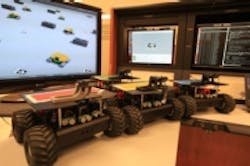NASA team developing “swarmie” robots for autonomous scouting and resource collection
Engineers at NASA's Kennedy Space Center in Florida have begun testing small robots and navigation software to see if it is possible for the autonomous machines to mimic the process that ants use to scout for and then collect resources.
The robots—which are being referred to as swarmies—resemble stripped-down, radio-controlled trucks and feature a webcam, WiFi antenna, and GPS device. They are being programmed to work on their own to survey an area, then call the other robots over if a cache of something valuable is found, similar to how an ant colony gathers around a food source to divide up the task of collecting food and taking it back to the nest, according to NASA.
The real testing being performed here is whether the software that will control the robots will work, and if the concept is worthwhile. In tests being performed in parking lots around the Kennedy Launch Control center, the robots are searching for barcoded pieces of paper. In the future, however, robots working in space missions would be equipped to scan the soil for water/ice or other resources that can be turned into rocket fuel or breathable air for astronauts.
"We're entering the phase where we do a ton of trial runs and collect the data and that’s well ahead of schedule," said Cheryle Mako, an engineer at Kennedy who is leading the project in the press release. "From an investigation perspective, we are spot-on and have made great strides."
During the testing, the engineers will use a computer simulator that will enable them to test the network with additional robots without actually having to build them. As testing proceeds, the team plans to include the RASSOR, an experimental mining robot also designed at Kennedy to try out different techniques for digging into the lunar or Martian surfaces to gather useful materials.
Assuming testing goes well, Mako also suggests that the swarmie system could be used on Earth for such tasks as search and rescue and pipeline inspection.
View the NASA press release.
Also check out:
Researchers developing NASA -inspired vision-enabled surgical robot for children
NASA engineer developing 3D printed space cameras
NASA to use Google’s 3D Project Tango devices in space station robots
Share your vision-related news by contacting James Carroll, Senior Web Editor, Vision Systems Design
To receive news like this in your inbox, click here.
Join our LinkedIn group | Like us on Facebook | Follow us on Twitter | Check us out on Google +
About the Author

James Carroll
Former VSD Editor James Carroll joined the team 2013. Carroll covered machine vision and imaging from numerous angles, including application stories, industry news, market updates, and new products. In addition to writing and editing articles, Carroll managed the Innovators Awards program and webcasts.
